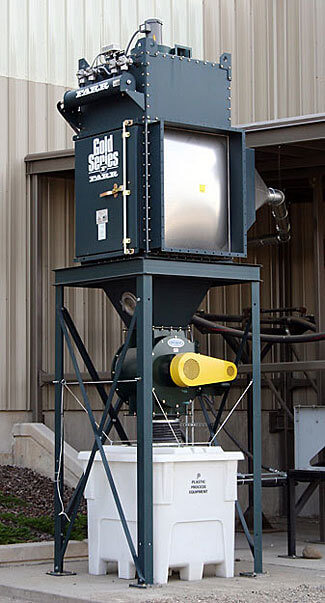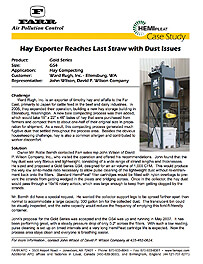
Case Study Details
Client Name
Ward Rugh, Inc.
Application
Hay Compacting
PDF Download
Challenge
Ward Rugh, Inc. is an exporter of timothy hay and alfalfa to the Far East, primarily to Japan for cattle feed in the beef and dairy industries. In 2005, they expanded their operation, building a new hay storage building in Ellensburg, Washington. A new bale compacting process was then added, which would take 18" x 22" x 46" bales of hay that were purchased from farmers and compact them to about one half of their original size in preparation for shipment. As a result, this compacting process generated fugitive dust that settled throughout the process area. Besides the obvious housekeeping challenge, hay is also a common allergen and contributed to worker discomfort.
Solution

GS4 on Hay Compacting at Ward Rugh, Inc.
Owner Mr. Rollie Bernth contacted John Wilson, Farr sales rep at David P. Wilson Company, Inc., who visited the operation and offered his recommendations. John found that the hay dust was very fibrous and lightweight, consisting of a wide range of strand lengths and thicknesses. He sized and proposed a GS4 Farr Gold Series® industrial dust collector designed for an air volume of 1000 CFM. This would produce the very low air-to-media ratio necessary to allow pulse cleaning of the lightweight dust without re-entrainment back onto the filters. Standard HemiPleat® filter cartridges would be fitted with nylon overbags to prevent the strands from getting wedged in the pleats and bridging across. Once in the collector, the hay dust would pass through a 16" x 16" rotary airlock, which was large enough to keep from getting clogged by the strands.
Mr. Bernth did have a special request. He wanted the collector support legs to be spread farther apart than normal to accommodate a large capacity, 300-gallon bin for the collected dust. The translucent bin could be visually inspected, and the extra capacity would reduce the frequency of emptying this forklift-friendly container.
John's proposal for the Farr Gold Series was accepted, and the GS4 was up and running in May 2007. It has been performing great with a steady pressure drop of only 0.2" across the filters. With such a low reading, pulse cleaning is set up on timed intervals and a very long HemiPleat cartridge life is expected. Now, the process area stays clean and everyone is breathing easier.
